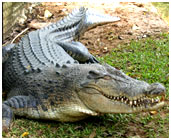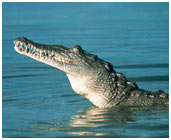Crocodile, amongst the ugliest reptiles, is found inhabiting mainly freshwater habitats. Check out some interesting facts and amazing information on Crocodiles.
Facts About Crocodile
Crocodile is a reptile that belongs to Crocodylidae family and Crocodilia order. Found inhabiting the tropics in Africa, Asia, the Americas and Australia, it looks like a huge lizard. Probably the most formidable of all reptiles, a crocodile has as many as 23 species, with the largest being that of ‘Saltwater Crocodile’ and smallest being that of ‘Dwarf Crocodile’. The average age of crocodiles is around 50 to 60 years; however, some of them have been known to live as long as 130 years. To help you gain more insight about crocodiles, we have provided some interesting facts and amazing information about them, in the following lines. 

Facts about Crocodile
Kingdom: Animalia
Phylum: Chordata
Class: Sauropsida
Order: Crocodilia
Family: Crocodylidae
Subfamily: Mekosuchinae (extinct), Crocodylinae and Tomistominae
Species: Around 23
Length: 1m to 5m (depending upon the species)
Largest Species: Saltwater Crocodile (Up to 7 m long and 1 tonne heavy)
Smallest Species: Dwarf Crocodile (Up to 2 m long)
Age: 50 to 60 years
Swimming Speed: 40 km per hour (25 mph)
Natural Habitat: Freshwater habitats like rivers, lakes, wetlands and, at times, brackish water
Diet: Fish, birds, mammals and, at times, smaller crocodiles
Gestation Period: 80 days
Number of Eggs: 20 to 80
Interesting and Amazing Information on Crocodiles
- The bite force of a crocodile is more than 5,000 pounds per square inch.
- Crocodiles have very sharp teeth that help them in tearing and holding onto flesh. However, they cannot open their mouth if it is held closed, even with the help of an adhesive tape.
- Crocodiles are much more closely related to birds and dinosaurs than the other reptiles.
- The sex of a crocodile is determined on the basis of its temperature. Males are produced at around 31.6 deg C and females, at slightly lower or higher temperature.
- A number of crocodile species can gallop, including Cuban crocodiles, New Guinea crocodiles, African dwarf crocodiles and Nile crocodiles.
- At time, a female crocodile helps the eggs hatch, by gently cracking the shells in her mouth.
- Crocodiles can produce sounds during distress as well as in aggressive displays.
- The tympanic membranes of a crocodile are concealed by flat flaps, enabling it can hear pretty well.
- The eggs of a crocodile are almost the same size as that of a goose.
- In many tribal societies, crocodile skin is regarded to be a symbol of high status.
- Only the belly skin of crocodiles is soft, the back skin is covered in bones. In fact, the back skin of a crocodile can reflect arrows, spears and even bullets!
- Crocodiles display increased aggressiveness during the mating season.
- Each crocodile jaw has 24 sharp teeth, used for grasping and crushing, but not chewing.
- The teeth of a crocodile get replaced continuously, throughout its life.
- Crocodiles sweat through their mouth and the gesture of lying with their mouth wide open is just a way to cool off.
- The crocodiles have a four-chambered heart, which behaves like a three-chambered reptilian one, when underwater.
- The first crocodiles appeared on earth, around 240 million years ago, around the same time as dinosaurs.
- The eyes of a crocodile reflect light, making them appear red, and make night vision possible.
- Crocodiles do not shed their skin, rather they grow into it.


See also
More from iloveindia.com
- Home Remedies | Ayurveda | Vastu | Yoga | Feng Shui | Tattoos | Fitness | Garden | Nutrition | Parenting | Bikes | Cars | Baby Care | Indian Weddings | Festivals | Party ideas | Horoscope 2015 | Pets | Finance | Figures of Speech | Hotels in India : Delhi | Hyderabad | Chennai | Mumbai | Kolkata | Bangalore | Ahmedabad | Jaipur
- Contact Us Careers Disclaimer Privacy Policy Advertise With Us Lifestyle Sitemap Copyright iloveindia.com. All Rights Reserved.




